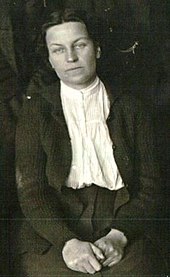Anastassija Alexejewna Bizenko
Anastassija Alexejewna Bizenko ( Russian Анастасия Алексеевна Биценко ; born November 10, 1875 in Alexandrowka, Ujesd Bachmut , Yekaterinoslav Governorate ; † June 16, 1938 ), English spelling also Anastasiya Bitsenko , was a Russian revolutionary .
Life
Anastassija Alexejewna Bizenko grew up in a farming family in the Ukraine. Like her husband, she was a member of the Social Revolutionary Party .
On November 22, 1905, she committed an assassination attempt on Adjutant General Viktor Sakharov , who was known as the "butcher of Saratov ". The court initially sentenced her to death for murder. She was exiled to Siberia on the basis of petitions that argued with her "insufficient intellectual development" and her "female gender". She spent the exile with five other women, all of whom belonged to the revolutionary underground and who became known as the Schesterka (Russian: six), including Maria Alexandrovna Spiridonova . During her trial, Bizenko refused to reveal her identity for months and stood before the court as a nameless person.

After her liberation through the revolution in 1917, Anastassija Alexejewna Bizenko was appointed as the only woman in the delegation that negotiated the Brest-Litovsk peace treaty and in which she represented the party of the Left Social Revolutionaries . During the negotiations with the Germans, her party rejected the peace treaty, and Bizenko joined the party of revolutionary communism , a splinter group of the former left social revolutionaries. She later joined the CPSU .
In 1938, Bizenko was shot in the course of the Stalinist purges and buried near Kommunarka .
literature
- Valentin Janin and others: Otetschestwennaja istorija: istorija Rossii s drewneischich wremen do 1917 goda: Tom 1 . Bolschaja Rossijskaja enziklopedija, Moscow 1994, ISBN 5-85270-076-2 , p. 238 (Russian).
- Richard Stites: The Women's Liberation Movement in Russia. Feminism, Nihilism, and Bolshevism, 1860-1930. Princeton University Press, Princeton (New Jersey) 1978, ISBN 978-0-691-10058-6 , p. 273 (English).
- Anthony Anemone (Ed.): Just Assassins. The Culture of Terrorism in Russia. Northwestern University Press, Evanston (Illinois) 2010, ISBN 978-0-8101-2692-3 , pp. 135 ff. (English).
Web links
- Anastasia Bitsenko going to the Brest-Litovsk peace meeting
- Video at the Federal Archives: The Armistice of Brest-Litovsk (Bizenko from 01:30 min.)
Individual evidence
- ↑ a b c List of people murdered during the Great Terror in the Moscow region (Russian); Retrieved May 27, 2013
- ↑ a b Anthony Anemone (Ed.): Just Assassins. The Culture of Terrorism in Russia , Northwestern University Press, Evanston (Illinois) 2010, pp. 135 ff.
- ↑ Sally A. Boniece: The Shesterka of 1905-06: Terrorist Heroines of Revolutionary Russia. In: Yearbooks for the History of Eastern Europe , Vol. 58, No. 2, 2010, ISSN 0021-4019 , pp. 172–191 (summary online) ( Memento from April 17, 2016 in the Internet Archive ).
- ↑ Prit Buttar: Between Giants. The Battle for the Baltics in World War II. Osprey Publishing, Oxford 2013, ISBN 978-1-4728-0288-0 (online) .
- ^ Notices from the Austrian State Archives. Volume 41, 1990, p. 268 (online) .
- ↑ Jane MacDermid, Anna Hillyar: Midwives of the revolution: female Bolsheviks and women workers in 1917, Ohio University Press 1999, ISBN 978-0-8214-1289-3 , pp. 55 ff.
- ↑ Winfried Becker: Frederic von Rosenberg (1874-1937). Diplomat from the late Empire to the Third Reich, Foreign Minister of the Weimar Republic. Vandenhoeck & Ruprecht, Göttingen 2011, ISBN 978-3-525-36076-7 , p. 277.
| personal data | |
|---|---|
| SURNAME | Bizenko, Anastassija Alexejewna |
| ALTERNATIVE NAMES | Bitsenko, Anastasiya; Биценко, Анастасия Алексеевна (Russian) |
| BRIEF DESCRIPTION | Russian revolutionary |
| DATE OF BIRTH | November 10, 1875 |
| PLACE OF BIRTH | Alexandrowka, Ujesd Bachmut , Yekaterinoslav Governorate |
| DATE OF DEATH | June 16, 1938 |
